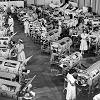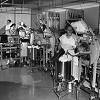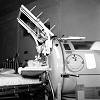Seeking Shade |
|
A PHP Error was encountered
Severity: Notice
Message: Only variables should be passed by reference
Filename: pages/site.php
Line Number: 13

- Also Known As:Camp Morrow, Downey Hospital, Hollydale Hospital, Los Angeles County Poor Farm
- Genre:Almshouse / Farm Colony, Psychiatric Hospital, Sanatorium / Isolation Hospital
- Comments: 407
- Built:1888
- Opened:1888
- Age:137 years
- Closed:N/A
- Demo / Renovated:N/A
- Decaying for:N/A
- Last Known Status:Abandoned (south campus)


Photo © 2009 Tom Kirsch, opacity.us
Rancho Los Amigos History
The southern campus of the Rancho Los Amigos Hospital is often referred to as the "Hollydale Mental Hospital" or the "Downey Insane Asylum" in contemporary times, however these misnomers paint an incorrect picture of the hospital's past use, which was much broader than just caring for the mentally ill. It was built in 1888 as a catch-all institution for the Los Angeles County Medical Center; a place to care for the handicapped, homeless, insane and elderly. The hospital was located in the former town of Hondo, which was absorbed by Downey in the 1950s. Funded by county bond money, it was simply called the County Poor Farm. Here, able-bodied residents could work on a large farm which sustained most of the hospital's dietary needs, in lieu of paying for room and board and medical care. These tenants were typically the homeless who drank too often, and just needed a few sober weeks of manual labor on the farm. Others worked on crafts such as wool clothes and rugs, which would be sold to the public. The 600 acres of property also encompassed an aviary, zoo, and rail line used for freight and passengers. Unclaimed bodies of residents who died at the poor farm were buried at a potter's field nearby, which has been relocated (but no one seems to know where, exactly) after torrential flooding washed away some of the caskets in 1914.
In 1918, the Spanish influenza epidemic hit the area, and the facility began treating all victims rather than just the indigent, and the word "Poor" was simply stricken from the name of the facility. The hospital expanded greatly in the 1920s to alleviate overcrowding conditions and rebuild flood-damaged structures, leading to the construction of the Spanish Colonial Revival buildings seen today. In 1932, the name of the institution was changed once again to Rancho Los Amigos, which translates to "Ranch of the Friends." The wide range of activities offered at the hospital were making it a legendary place to receive physical and occupational therapy; swimming, woodworking and weaving proved to help restore broken limbs and spirits. One example was that of a man with a badly crippled left arm and hand; the therapist placed a sanding block in it and directed the patient to sand furniture, which exercised the muscles and the patient also earned his own stipend to spend at the hospital store. Another patient who suffered from polio learned to paint by wielding an artist's brush between her teeth after 10 years of recovery.
After the Long Beach earthquake disaster in 1933, a large group of Rancho patients flooded the county supervisor Roger Jessup's office. They told tragic tales in hopes that he would push for funding improvements at Rancho to help the many victims. Some of these real-life stories were so traumatic that Jessup's secretary, Grace Wagner, became "hysterical" after hearing them, and actually leaped out of the office window and plummeted to her death.
During World War II, the U.S. Army turned part of the hospital grounds into Camp Morrow, and at the same time the facility operated as an emergency hospital. It was reorganized once again as a long-term care facility after the war, mostly for victims of polio. Entire wards were filled with iron lungs in the 1950s, humming and clicking away, breathing for the victims inside as they recuperated. The discovery of the Salk polio vaccine in 1955 put most of those machines in storage, however a few still operated at Ranchos for children who were given a bad batch of the vaccine for years after.
By the late 1950s, the farm, dairy, and mental health wards had closed, and most of the 600 acre property was divided and sold. Rancho continued to operate as a modern chronic-disease hospital, and later, a world-renowned rehabilitation center. All these operations were consolidated and moved to Rancho's north campus, a 62 acre hospital site that still operates today. The 70 acre south campus became something like a ghost town, with a multitude of shuttered treatment buildings surrounding a movie theater and power plant. The actual date of the closure of the south campus is uncertain, but it is known that the buildings there were used for storage by 1988.
The U.S. Marine Corps occasionally used the south campus to perform military training drills. During one of the exercises, troops opened a freezer in a former pathology building and discovered a package full of mummified body parts. The coroner's office identified 10 legs, feet and brain matter, and determined that these were amputated medical specimens, rather than the result of foul play. A L.A. Times article reports that they were simply "forgotten in a long-ago move."
Redevelopment plans for the south campus have languished for the most part, but a few buildings have been re-purposed. For more history and historical photos of the hospital, check out the book Rancho Los Amigos Medical Center 1888-1988, by Colleen Adair Fliedner.




